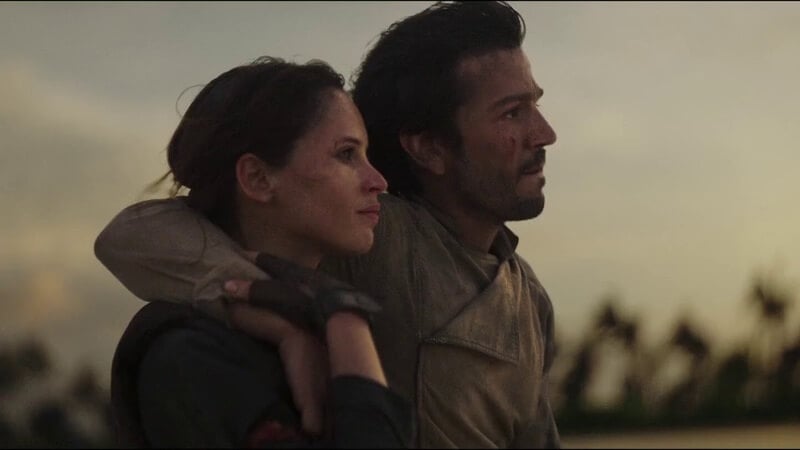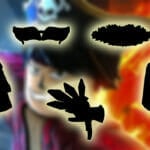Rogue One is a rare type of movie. Its central premise – the tale of the rebels who stole the Death Star plans – didn’t need to be told. And yet, when Disney told this story, it turned out to be better than it had any right to be.
To understand the pleasant surprise that was Rogue One, you need to look at the movie’s context. By this time, Disney had only held the Star Wars license for four years. And 2014’s Star Wars: The Force Awakens, while popular with critics and fans alike, was a tit-for-that remake of 1978’s A New Hope.
So, when Rogue One hit the silver screen, it presented an opportunity to explore a different side of Star Wars. There’s no ‘Chosen One’ here, no laser-sword-wielding Jedi or dark-side-light-side contrast. Disney’s first A Star Wars Story is relatively grounded (or as grounded as the franchise can be, at any rate) and tells the story of the little people whose bravery paves the way for Luke Skywalker, Han Solo, and Princess Leia et al. Is Rogue One Disney’s best-ever Star Wars movie, 6 years on?
A Force like None Other
Although Rogue One came out in 2016, the origin of Disney’s best Star Wars movie lie roughly eleven years prior. Visual effects designer John Knoll conceived the idea for the story circa 2005 while working on Revenge of the Sith. During this period, the film’s producer, Rick McCallum, and George Lucas were developing a live-action Star Wars TV Show. Knoll pitched the idea of a “Mission: Impossible-style spy mission to steal the Death Star plans” for one of the episodes.
However, after talking to McCallum about the episode, Knoll realized it wouldn’t fit the premise he and Lucas were gunning for. And, in any case, the work-in-progress Star Wars show never saw the light of day. However, Knoll realized his idea had potential as a standalone film. After Disney’s acquisition of Lucasfilm in 2012, Knoll saw an additional opportunity to bring his idea to life. Encouraged by friends, Knoll pitched Rogue One to Kathleen Kennedy and Kiri Hart – and, well, you see what happened.
Gareth Edwards, a British VFX artist, was hired to direct the film. Edwards was halfway through directing the 2014 Godzilla reboot when he was approached to helm the movie. He was so burned out from the monster flick that he secretly hoped the idea would be so bad that he’d have to reject the project. As it turns out, Rogue One‘s story was quality enough for Edwards to sign on.
War is Messy
Think back to the original Star Wars trilogy. How did they make you feel? For all their science-fiction stylings, many would argue that those first three movies ultimately felt like fairy tales. And in the best possible way. I mean, intangible magical powers, little cute teddy bears, an evil wizard in black, a growing lad with an unavoidable destiny…the pieces are all there. And I haven’t even gotten to the little green man who happens to be the wisest wizard of them all.
Now, these movies are classics for a reason. But there’s something the Star Wars movies have never really delved into. That is to say, the horror and tragedy that comes from war. In the original trilogy, most of the Rebel-vs-Empire conflict is sidelined in favor of Luke’s adventures. We see the parts that Luke, Han, and Leia are involved in (the heroes bedecked in Plot Armor) – but we don’t see much from the ‘little people’ and their struggles.
Rogue One, on the other hand, does exactly this. The story unites a ragtag group of unlikely heroes – an outlaw Jyn Erso (Felicity Jones), Cassian Andor (Diego Lunar, set to reprise the role in the upcoming series), Chirrut Îmwe, Baze Malbus, and Bodhi Rook. All these characters join the fight for different reasons (and, as is nature for standalone movies, some character development is better than others). None of these characters have special powers or foretold destinies but help save the universe via their own skills.
Taking on the Death Star
When discussing the influences behind Rogue One, Gareth Edwards came out with some surprising mentions. Among them, he claimed, were Saving Private Ryan and Black Hawk Down. These movies seem largely at odds with Star Wars, but when you sit down with RO, you realize the connection. And this isn’t only evident in the movie’s dreary color palette but also in the story itself.
One of the movie’s most impactive scenes occurs during the mission to Eadu. Jyn Erso accompanies Cassian Andor to rescue her father, the scientist who designed the Death Star. Or, at least, that’s what she initially thinks is the goal. The twist comes when Rebel bombers start attacking the facility, fatally wounding Erso’s dad. It turns out Cassian was actually sent to assassinate Galen Erso to ensure he didn’t help the Empire build any more weapons of terror. But when his communications die, the Alliance send bombers anyway to finish Galen off.
This Rogue One moment illustrates best what Disney’s first spin-off Star Wars movie does. It paints the Rebels in a somewhat shady light. It shows that the Rebel Alliance is willing to go to morally-eerie ways to achieve its aims. Just through this scene alone, Rogue One gives an extra dimension to the war that previous movies didn’t. In the original trilogy, the rebels were depicted as clean, innocent ‘good guys.’ Comparatively, this film makes them far more interesting (and believable) because it isn’t afraid to depict the more corrupt ways the alliance deals with things.
High-Stakes Star War
What’s more, the creative decision to off its heroes is a brave one. Edwards claims that the original ending had all the heroes return alive (well, apart from the droid, K-2SO). Understandably, the director thought that family-friendly Disney would never go with the ending where the entire main cast perish. And yet, much to his (and, indeed, our) surprise, producers insisted on having the tragic ending where Jyn and company die shortly after transferring the Death Star plans to the Rebel Alliance.
This gives Rogue One a high-stake feeling that other Star Wars movies don’t have. This isn’t a tale where the heroes all survive, get their medals, and live happily ever after. There’s a victory here, to be sure – but, like any war, it comes with a huge cost. And sadly, this is a concept not explored often enough in Star Wars. Indeed, given the franchise’s title, you’d think they’d do that more. Harrison Ford famously wanted his iconic mercenary, Han Solo, to die in Return of the Jedi to lend “gravitas” to his trilogy’s closing episode. However, the actor wouldn’t get his wish until 2014’s The Force Awakens – and even then, his death felt a bit ‘tacked on’ to the sequel trilogy’s newly-established storyline.
Now, the characters in Rogue One aren’t perfect. As is the case with ensemble cast films, some characters are given more time to develop than others. In this case, Jyn Erso and Cassian Andor are given far more attention than Chirrut Îmwe, Baze Malbus and Bodhi Rook. Chirrut and Malbus are a fun comedic duo – mystical man and sceptical man butting heads – but their backgrounds aren’t explored a great deal. Meanwhile, Bodhi Rook remains the film’s weakest character, feeling more like a plot tool than a character. That said, each character is likable to the extent that it hurts to see them go.
In The End
However, despite its shortcomings, Rogue One remains Disney’s bravest venture into the franchise yet. It keeps the familiar elements of Star Wars – droids, X-Wings, Darth Vader, Rebels vs. Empire – and uses them to craft something original. Whereas the sequel trilogy feels like a soft remake of the first trilogy, Rogue One is like a fresh, well-crafted story. And the fact that it also possesses the most bad-ass Darth Vader scene in cinematic history is simply a bonus. The movie is heartbreaking but full of hope.
And that’s just what Star Wars should be.
But that’s just our take. Do you think Disney’s Rogue One is the best Star Wars movie? Or have they done better?










